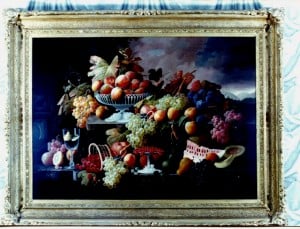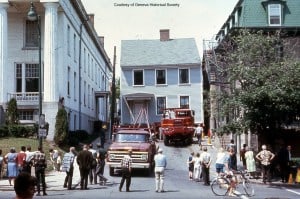When you move something, is it still the same?
By John Marks, Curator of Collections and Exhibits
I wrote in March about cleaning out the house in which I grew up. We needed to “de-clutter” it anyway to put it on the market so we did the bulk of the removal at the same time. All the dishes, books, cereal boxes, knick knacks, records, and “what is this and why did they save it?” left the house. It was a huge feat but, as anyone who has been through this knows, it was far from being finished.
There was a desk in our front hallway. Mom wasn’t a big furniture re-arranger, it stayed there the entire time they owned the house. It looked like it had been made for that corner. Sadly I never got the full story on the old furniture in the house but it was a family piece, from one side or the other. I didn’t want many things from the house but I did claim the desk.
The desk always had a lovely, unique aroma. As I began to clean it out before moving it I located the elements of this smell. In no particular order, there were: color slides and negatives, newspaper clippings (including coupons for products not made in 30 years), glossy travel brochures (including a 1968 Rose Hill pamphlet), matchbooks, plastic doo-dads, and fountain pen ink. All sealed up in an old wooden desk for 50 years.
The desk was one of the last big items to leave the house. I admit to exaggeration in all stories, but I swear I felt a disturbance in the universe as I pulled it away from the wall. My late mother pulled one last joke to break up the somber moment. I removed the drawers and I thought I had cleaned out the top section “good enough” for moving. As I lifted it onto the truck, tiny stuff rained out of the desk. Hole punch reinforcements, pennies, foreign coins, plastic stitch counters, and tiny chain rings covered the porch and front walk. Mom would have found that hilarious.
Once I moved the desk into the storage unit I got a good look at it. It may have been purchased from a mail order catalogue. It was solid factory furniture but nothing special. There were many scratches from years of use; the heavy rotary phone sat on top and scraped back and forth until my parents went cordless. There was light mold on the back and bottom from decades of being against a wall. I began to question what the desk was and why I was keeping it. (Of course I’m keeping it, are you nuts?)
This is a question pondered by preservationists – of objects and architecture alike – for decades: When you move something, is it still the same? While artifacts are meant to be movable, they still form a bond with their home. Historic house visitors recognize this. The most common question (and one I asked as a child) is, “Were these things originally here?” There is something special about seeing a painting or sofa in THE EXACT SPOT that a family saw it and used it 150 years ago.
This still life by Severin Roesen in the Rose Hill dining room was in the same spot when the Swan family lived there in the late 1800s.
This is a bigger question in historic preservation. Living history museums such as The Farmers’ Museum in Cooperstown, New York and Greenfield Village in Dearborn, Michigan collected old buildings and re-created villages of yore. Some/ many/ all of these structures may have been destroyed, or fallen down from neglect if they hadn’t been moved. So one viewpoint is, “Saving the architecture is the most important thing, the site doesn’t matter.”
When Geneva High School expanded, the Ludlow house was moved from Pulteney Street to South Main Street to save it.
Others believe that the site is everything. Archeologists certainly believe this. An 18th-century house on its original foundation will be surrounded with underground evidence of what people ate and owned and ultimately buried in the ground. Houses are built according to their surroundings: near or removed from a road, oriented to catch more sunlight or the prevailing breezes, etc. Emotionally, one can see the same geography that people saw centuries before.
Everyone decides the answer to this question for themselves. You are able to stand in Thomas Edison’s laboratory in Greenfield Village that was moved from Menlo Park, New Jersey. You can also stand on John Johnston’s porch in Seneca County, owned by the Geneva Historical Society, and see the very ground that inspired him to install tile drainage on his farm. If a giant corporation somehow took over our property and we had to move the Johnston house, would it be the same?



